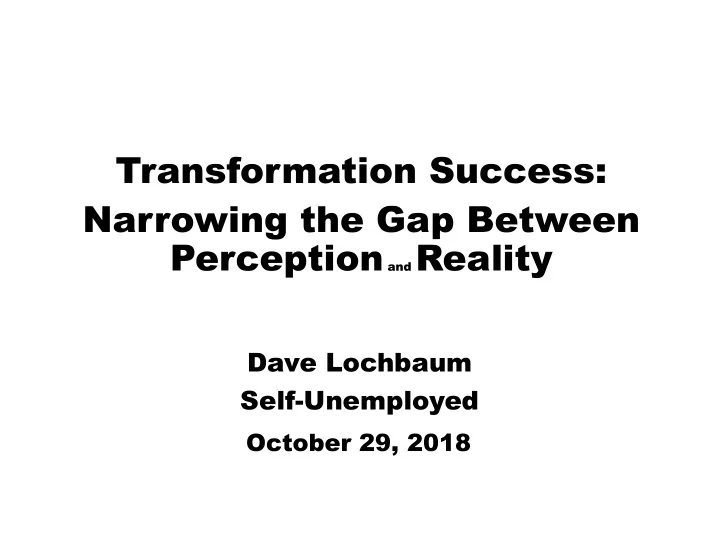

Transformation Success: Narrowing the Gap Between Perception and Reality Dave Lochbaum Self-Unemployed October 29, 2018
NRC has demonstrated proficiency at responding swiftly and effectively to unanticipated safety and security challenges (e.g., PWR CRDM nozzle cracking in spring 2001 and 9/11 later that year) NRC can successfully apply that capacity to future challenges such as those listed in SECY-18-0060 BUT , and it’s a big BUT : Transformation success depends on keeping the gap between perception and reality as narrow as possible. 2
52 year-plus outages to restore safety levels to acceptable levels, 50 on NRC’s watch Source: UCS report No More Fort Calhouns!, February 2015. Online at http://www.ucsusa.org/sites/default/files/attach/2015/03/np-ft-calhouns-full- report.pdf?_ga=2.196753579.62578069.1538585309-730957765.1502383429 3
Lessons from year-plus reactor outages: 1. Owners were not knowingly operating unsafe reactors, hoping not to get caught. 2. Owners were operating what they perceived to be sufficient safe reactors, but they were not. 3. The gap between perception and reality is reflected by the time required to re-close the gap. 4. 44 year-plus outages during the SALP years (1980- 1999), an average of 2.2 per year 5. 2 year-plus outages during the ROP years (2000- date), an average of less than 0.11 per year 6. ROP narrowed the gap between perception and reality, thus preventing uncorrected safety problems from growing to the point where it takes longer than a year to remedy them once detected 4
Lessons from ROP for transformations: 1. Unintended consequences and initially correct deferral decisions undermined by changing landscapes need to be detected and corrected in a timely and effective manner. 2. Baseline gap-monitoring for non-transformation areas (aka back-burner issues) to guard against undue delays and cumulative effects of non- regulation. 3. To maximum extend practical, objective metrics needed to ensure desired outcomes are achieved without unintended consequences. 4. ROP is superior to SALP , but not infallible. 5
Davis-Besse Perception (SALP) SALP perceived Davis-Besse to be a top performer 6
Davis-Besse Perception (ROP) ROP also perceived Davis-Besse to be a top performer 7
Davis-Besse Reality Reality showed Davis-Besse to have come closer to accident than any reactor since Three Mile Island 8
NRC and industry are on the same page (often the same sentence on the same page) for many risk calculations, such as: 1. Peak cladding temperatures during postulated loss of coolant accidents 2. Peak containment pressures during postulated steam line break accidents 3. Steam generator tube wall crack growth rates 4. Pipe wall thinning rates due to erosion/corrosion 5. Safety-related component failures to start and failures to run Unless both are wrong, tiny gap between perception and reality 9
NRC and industry are not in the same book, yet alone on the same page, for high risks Whichever is wrong, massive gap between perception and reality 10 10
My prime concern with transformations: Changes are not occurring in isolation, enabling progress towards desired outcome to be effectively monitored and mid-course corrections implemented, if necessary. Instead, transformations are proposed concurrent with extensive changes to the ROP and other regulatory constructs. Can performance shortfalls be readily and reliably detected when the yardsticks are all new without proven track records? I know the perception is “yes, of course.” But is that also the real answer? 11
Gap management straw-persons: 1. Annual self-evaluations by two NRC teams. a) One team looking for evidence that desired outcomes have been achieved or are on- target to do so. b) One team looking for evidence of unintended consequences from transformation initiatives and adverse consequences in non-transformation areas. 2. Commission briefing and/or ACRS meeting with presentations by both teams 12
List of Acronyms ACRS – Advisory Committee on Reactor Safeguards CDF – Core damage frequency CFR – Code of Federal Regulations CRDM – Control Rod Drive Mechanism ENG - Engineering MAINT - Maintenance NRC – Nuclear Regulatory Commission OPS – Operations PS – Plant Support (e.g., training, security, etc._ PWR – Pressurized Water Reactor ROP – Reactor Oversight Process SALP – Systematic Assessment of Licensee Performance 13
Recommend
More recommend